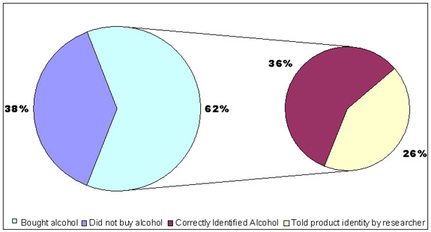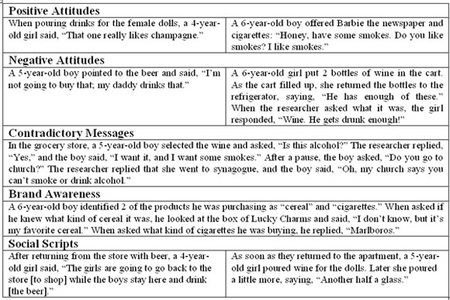The DRAM, Vol. 4(4) – Let’s play house. I’ll bring the wine and you bring the beer
Environmental factors influence attitudes and opinions. Together, these influences play a key role in one’s perception of substances of abuse (e.g., alcohol). Research examining the “nurture” of nature vs. nurture is rarely conducted using preschool-aged children. Dalton et al.(2005) studied preschool age children using a role play and observation style study. This week’s DRAM explores how exposure to parental social situations affects preschoolers’ ideas about alcohol.
In this study, Dalton et al. (2005) gave children the following props: a Barbie store stocked with 133 miniature items representing 73 different products, a kitchen, a living room, a car, and 4 adult dolls (2 male, 2 female). Role-play for 3-6 year olds included conversing with the researcher (who played the role of the “friend” and “cashier”) and for 2-year olds, choosing a doll and taking it to the store. Children could purchase any items from the store directly if they correctly identified the items to the “cashier” at the “checkout” or, they could purchase incorrectly or unidentified items if they wanted to after explicitly asking and/or being told what the items were. Researchers also surveyed the preschoolers’ parents to measure how often they drank alcoholic beverages (monthly or more) and how often they allowed the children to watch certain types of movies (G-rated, PG-rated, or PG-13 / R-rated).
Of the 120 children (ages 2-6), 74 bought alcohol and 43 of them identified it on their own. Of the 31 (42%) who were told by the researcher that the item was alcohol, six did not recognize the product as alcohol and explicitly asked the identity, and 25 originally misidentified it and were told it was alcohol (see Figure 1). The adjusted odds of purchasing an alcohol item were 3 times greater if parents drank alcohol “once a month or more.” The adjusted odds ratio for alcohol purchases for children who watched PG-13/R-rated movies was 5 times greater than the odds ratio for those children who watched PG and G-rated movies monthly or less (Dalton et al., 2005).¹

Figure 1. Alcohol purchasing trends among preschoolers. Click image to enlarge.
This study’s limitations include some uncontrollable factors. First, researchers did not measure or control for differences in child rearing practices. Therefore, they could not evaluate possible extended family and friend influences, or media influence. Second, the study was limited by preschool children’s language and reasoning abilities. Although they collected parental data and examined the correlation parent and child behaviors, researchers were forced to rely mainly on observational data, which is more difficult to quantify.
Preschoolers’ reactions and perceived attitudes regarding alcohol and drug use varied from positive to negative. Some children had less apparent reactions and were preoccupied with the situation or the brand. Figure 1 presents vignettes from role playing, which illustrate how the children’s’ speech reflects the differences in reactions and attitudes. The study indicates that, even at the young age of 2, children are observant of parental behaviors and aware of the positive and negative associations that their parents have with alcohol. Researchers focused on the alcohol and cigarette social script² (Dalton et al., 2005), which children acquired as a result of observing and interacting with their parents. The results suggest that children are not too young to discuss the risks and benefits of certain behaviors. It is interesting to consider that parents might be motivated to change their behavior when they recognize the influence it has on their children’s attitudes.

Figure 2. Vignettes from role-playing: Differences in attitudes (adapted from Dalton et al., 2005). Click image to enlarge.
—Ingrid R. Maurice
What do you think? Please use the comment link below to provide feedback on this article.
________________
[1] Odds Ratios were adjusted for other demographic variables (.e.g. children’s’ ages and genders, and parents’ ages and education levels) (Dalton et al., 2005)
[2] (a) As defined by researchers, social scripts represent children’s use of products as though they were part of a scripted scene. (b) Cognitive Script: “coherent sequences of events expected by an individual and that involve him or her as a participant or an observer”. (Abelson RP. Script processing in attitude formation and decision making. In: Carroll J, Payne W, eds. Cognition and Social Behavior. Hillsdale, NJ: L Erlbaum Associates; 1976)
References
Dalton, M. A., Bernhardt, A. M., Gibson, J. J., Sargent, J. D., Beach, M. L., Adachi-Mejia, A. M., et al. (2005). Use of Cigarettes and Alcohol by Preschoolers While Role-playing as Adults. Archives of Pediatric & Adolescent Medicine(159), 854-859.